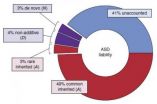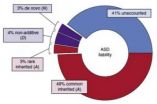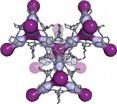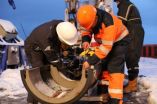(Press-News.org) Most of the genetic risk for autism comes from versions of genes that are common in the population rather than from rare variants or spontaneous glitches, researchers funded by the National Institutes of Health have found. Heritability also outweighed other risk factors in this largest study of its kind to date.
About 52 percent of the risk for autism was traced to common and rare inherited variation, with spontaneous mutations contributing a modest 2.6 percent of the total risk.
"Genetic variation likely accounts for roughly 60 percent of the liability for autism, with common variants comprising the bulk of its genetic architecture," explained Joseph Buxbaum, Ph.D., of the Icahn School of Medicine at Mount Sinai (ISMMS), New York City. "Although each exerts just a tiny effect individually, these common variations in the genetic code add up to substantial impact, taken together."
Buxbaum, and colleagues of the Population-Based Autism Genetics and Environment Study (PAGES) Consortium, report on their findings in a unique Swedish sample in the journal Nature Genetics, July 20, 2014.
"Thanks to the boost in statistical power that comes with ample sample size, autism geneticists can now detect common as well as rare genetic variation associated with risk," said Thomas R. Insel, M.D., director of the NIH's National Institute of Mental Health (NIMH). "Knowing the nature of the genetic risk will reveal clues to the molecular roots of the disorder. Common variation may be more important than we thought."
Although autism is thought to be caused by an interplay of genetic and other factors, including environmental, consensus on their relative contributions and the outlines of its genetic architecture has remained elusive. Recently, evidence has been mounting that genomes of people with autism are prone to harboring rare mutations, often spontaneous, that exert strong effects and can largely account for particular cases of disease.
More challenging is to gauge the collective impact on autism risk of numerous variations in the genetic code shared by most people, which are individually much subtler in effect. Limitations of sample size and composition made it difficult to detect these effects and to estimate the relative influence of such common, rare inherited, and rare spontaneous variation.
Differences in methods and statistical models also resulted in sometimes wildly discrepant estimates of autism's heritability – ranging from 17 to 50 percent.
Meanwhile, recent genome-wide studies of schizophrenia have achieved large enough sample sizes to reveal involvement of well over 100 common gene variants in that disorder. These promise improved understanding of the underlying biology – and even development of risk-scores, which could help predict who might benefit from early interventions to nip psychotic episodes in the bud.
With their new study, autism genetics is beginning to catch up, say the researchers. It was made possible by Sweden's universal health registry, which allowed investigators to compare a very large sample of about 3,000 people with autism with matched controls. Researchers also brought to bear new statistical methods that allowed them to more reliably sort out the heritability of the disorder. In addition, they were able to compare their results with a parallel study in 1.6 million Swedish families, which took into account data from twins and cousins, and factors like age of the father at birth and parents' psychiatric history. A best-fit statistical model took form, based mostly on combined effects of multiple genes and non-shared environmental factors.
"This is a different kind of analysis than employed in previous studies," explained Thomas Lehner, Ph.D., chief of NIMH's Genomics Research Branch. "Data from genome-wide association studies was used to identify a genetic model instead of focusing just on pinpointing genetic risk factors. The researchers were able to pick from all of the cases of illness within a population-based registry."
Now that the genetic architecture is better understood, the researchers are identifying specific genetic risk factors detected in the sample, such as deletions and duplications of genetic material and spontaneous mutations. Even though such rare spontaneous mutations accounted for only a small fraction of autism risk, the potentially large effects of these glitches makes them important clues to understanding the molecular underpinnings of the disorder, say the researchers.
"Within a given family, the mutations could be a critical determinant that leads to the manifestation of ASD in a particular family member," said Buxbaum. "The family may have common variation that puts it at risk, but if there is also a de novo [spontaneous} mutation on top of that, it could push an individual over the edge. So for many families, the interplay between common and spontaneous genetic factors could be the underlying genetic architecture of the disorder."
INFORMATION:
Other lead investigators on the study were: Christina Hultman, Ph.D., Karolinska Institute, Stockholm, Sweden; Bernie Devlin, Ph.D., University of Pittsburgh; Avraham Reichenberg, Ph.D., ISMMS; Kathryn Roeder, Ph.D., Carnegie Mellon University, Pittsburgh.
The research was funded, in part, by grants from the NIH's NIMH, Eunice Kennedy Shriver National Institute of Child Health and Human Development, and National Institute on Neurological Disorders and Stroke.
Reference:
Gaughler T, Klei L, Sanders SJ, Bodea CA, Goldberg AP, Lee AB, Mahajan M, Manaa D, Pawitan Y, Reichert J, Ripke S, Sandin S, Sklar P, Svantesson O, Reichenberg A, Hultman CH, Devlin B, Roeder K, Buxbaum JD. Most genetic risk for autism resides with common variation. Nature Genetics, July 20, 2014.
About the National Institute of Mental Health (NIMH): The mission of the NIMH is to transform the understanding and treatment of mental illnesses through basic and clinical research, paving the way for prevention, recovery and cure. For more information, visit http://www.nimh.nih.gov.
About the Eunice Kennedy Shriver National Institute of Child Health and Human Development (NICHD): The NICHD sponsors research on development, before and after birth; maternal, child, and family health; reproductive biology and population issues; and medical rehabilitation. For more information, visit the Institute's website at http://www.nichd.nih.gov/.
NINDS is the nation's leading funder of research on the brain and nervous system. The mission of NINDS is to seek fundamental knowledge about the brain and nervous system and to use that knowledge to reduce the burden of neurological disease.
About the National Institutes of Health (NIH): NIH, the nation's medical research agency, includes 27 Institutes and Centers and is a component of the U.S. Department of Health and Human Services. NIH is the primary federal agency conducting and supporting basic, clinical, and translational medical research, and is investigating the causes, treatments, and cures for both common and rare diseases. For more information about NIH and its programs, visit http://www.nih.gov.
Common gene variants account for most genetic risk for autism
Roles of heritability, mutations, environment estimated -- NIH-funded study
2014-07-20
ELSE PRESS RELEASES FROM THIS DATE:
Genetic risk for autism stems mostly from common genes
2014-07-20
PITTSBURGH—Using new statistical tools, Carnegie Mellon University's Kathryn Roeder has led an international team of researchers to discover that most of the genetic risk for autism comes from versions of genes that are common in the population rather than from rare variants or spontaneous glitches.
Published in the July 20 issue of the journal "Nature Genetics," the study found that about 52 percent of autism was traced to common genes and rarely inherited variations, with spontaneous mutations contributing a modest 2.6 percent of the total risk. The research team — ...
A noble gas cage
2014-07-20
Richland, Wash. -- When nuclear fuel gets recycled, the process releases radioactive krypton and xenon gases. Naturally occurring uranium in rock contaminates basements with the related gas radon. A new porous material called CC3 effectively traps these gases, and research appearing July 20 in Nature Materials shows how: by breathing enough to let the gases in but not out.
The CC3 material could be helpful in removing unwanted or hazardous radioactive elements from nuclear fuel or air in buildings and also in recycling useful elements from the nuclear fuel cycle. CC3 ...
New method for extracting radioactive elements from air and water
2014-07-20
LIVERPOOL, UK – 20 July 2014: Scientists at the University of Liverpool have successfully tested a material that can extract atoms of rare or dangerous elements such as radon from the air.
Gases such as radon, xenon and krypton all occur naturally in the air but in minute quantities – typically less than one part per million. As a result they are expensive to extract for use in industries such as lighting or medicine and, in the case of radon, the gas can accumulate in buildings. In the US alone, radon accounts for around 21,000 lung cancer deaths a year.
Previous ...
Singapore scientists discover genetic cause of common breast tumours in women
2014-07-20
Singapore, 21 July 2014 – A multi-disciplinary team of scientists from the National Cancer Centre Singapore, Duke-NUS Graduate Medical School Singapore, and Singapore General Hospital have made a seminal breakthrough in understanding the molecular basis of fibroadenoma, one of the most common breast tumours diagnosed in women. The team, led by Professors Teh Bin Tean, Patrick Tan, Tan Puay Hoon and Steve Rozen, used advanced DNA sequencing technologies to identify a critical gene called MED12 that was repeatedly disrupted in nearly 60% of fibroadenoma cases. Their findings ...
New technique maps life's effects on our DNA
2014-07-20
Researchers at the BBSRC-funded Babraham Institute, in collaboration with the Wellcome Trust Sanger Institute Single Cell Genomics Centre, have developed a powerful new single-cell technique to help investigate how the environment affects our development and the traits we inherit from our parents. The technique can be used to map all of the 'epigenetic marks' on the DNA within a single cell. This single-cell approach will boost understanding of embryonic development, could enhance clinical applications like cancer therapy and fertility treatments, and has the potential ...
CU, Old Dominion team finds sea level rise in western tropical Pacific anthropogenic
2014-07-20
A new study led by Old Dominion University and the University of Colorado Boulder indicates sea levels likely will continue to rise in the tropical Pacific Ocean off the coasts of the Philippines and northeastern Australia as humans continue to alter the climate.
The study authors combined past sea level data gathered from both satellite altimeters and traditional tide gauges as part of the study. The goal was to find out how much a naturally occurring climate phenomenon called the Pacific Decadal Oscillation, or PDO, influences sea rise patterns in the Pacific, said ...
Common gene variants account for most of the genetic risk for autism
2014-07-20
Nearly 60 percent of the risk of developing autism is genetic and most of that risk is caused by inherited variant genes that are common in the population and present in individuals without the disorder, according to a study led by researchers at the Icahn School of Medicine at Mount Sinai and published in the July 20 edition of Nature Genetics.
"We show very clearly that inherited common variants comprise the bulk of the risk that sets up susceptibility to autism," says Joseph D. Buxbaum, PhD, the study's lead investigator and Director of the Seaver Autism Center for ...
Tiny laser sensor heightens bomb detection sensitivity
2014-07-20
Berkeley — New technology under development at the University of California, Berkeley, could soon give bomb-sniffing dogs some serious competition.
A team of researchers led by Xiang Zhang, UC Berkeley professor of mechanical engineering, has found a way to dramatically increase the sensitivity of a light-based plasmon sensor to detect incredibly minute concentrations of explosives. They noted that it could potentially be used to sniff out a hard-to-detect explosive popular among terrorists.
Their findings are to be published Sunday, July 20, in the advanced online ...
Size and age of plants impact their productivity more than climate, study shows
2014-07-20
The size and age of plants has more of an impact on their productivity than temperature and precipitation, according to a landmark study by University of Arizona researchers.
UA professor Brian Enquist and postdoctoral researcher Sean Michaletz, along with collaborators Dongliang Cheng from Fujian Normal University in China and Drew Kerkhoff from Kenyon College in Gambier, Ohio, have combined a new mathematical theory with data from more than 1,000 forests across the world to show that climate has a relatively minor direct effect on net primary productivity, or the amount ...
Mixing it up: Study provides new insight into Southern Ocean behaviour
2014-07-20
A new study has found that turbulent mixing in the deep waters of the Southern Ocean, which has a profound effect on global ocean circulation and climate, varies with the strength of surface eddies – the ocean equivalent of storms in the atmosphere – and possibly also wind speeds.
It is the first study to link eddies at the surface to deep mixing on timescales of months to decades.
This new insight into how the Southern Ocean behaves will allow scientists to build computer models that can better predict how our climate is going to change in the future.
The findings ...
LAST 30 PRESS RELEASES:
Numbers in our sights affect how we perceive space
SIMJ announces global collaborative book project in commemoration of its 75th anniversary
Air pollution exposure and birth weight
Obstructive sleep apnea risk and mental health conditions among older adults
How talking slows eye movements behind the wheel
The Ceramic Society of Japan’s Oxoate Ceramics Research Association launches new international book project
Heart-brain connection: international study reveals the role of the vagus nerve in keeping the heart young
Researchers identify Rb1 as a predictive biomarker for a new therapeutic strategy in some breast cancers
Survey reveals ethical gaps slowing AI adoption in pediatric surgery
Stimulant ADHD medications work differently than thought
AI overestimates how smart people are, according to HSE economists
HSE researchers create genome-wide map of quadruplexes
Scientists boost cell "powerhouses" to burn more calories
Automatic label checking: The missing step in making reliable medical AI
Low daily alcohol intake linked to 50% heightened mouth cancer risk in India
American Meteorological Society announces Rick Spinrad as 2026 President-Elect
Biomass-based carbon capture spotlighted in newly released global climate webinar recording
Illuminating invisible nano pollutants: advanced bioimaging tracks the full journey of emerging nanoscale contaminants in living systems
How does age affect recovery from spinal cord injury?
Novel AI tool offers prognosis for patients with head and neck cancer
Fathers’ microplastic exposure tied to their children’s metabolic problems
Research validates laboratory model for studying high-grade serous ovarian cancer
SIR 2026 delivers transformative breakthroughs in minimally invasive medicine to improve patient care
Stem Cell Reports most downloaded papers of 2025 highlight the breadth and impact of stem cell research
Oxford-led study estimates NHS spends around 3% of its primary and secondary care budget on the health impacts of heat and cold in England
A researcher’s long quest leads to a smart composite breakthrough
Urban wild bees act as “microbial sensors” of city health.
New study finds where you live affects recovery after a hip fracture
Forecasting the impact of fully automated vehicle adoption on US road traffic injuries
Alcohol-related hospitalizations from 2016 to 2022
[Press-News.org] Common gene variants account for most genetic risk for autismRoles of heritability, mutations, environment estimated -- NIH-funded study






